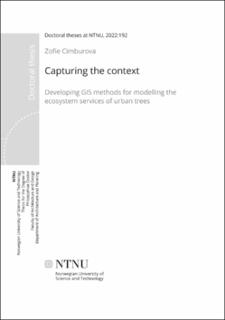| dc.contributor.advisor | Frøyen, Yngve K. | |
| dc.contributor.advisor | Pont, Meta Berghauser | |
| dc.contributor.advisor | Barton, David | |
| dc.contributor.author | Cimburova, Zofie | |
| dc.date.accessioned | 2022-06-14T14:02:21Z | |
| dc.date.available | 2022-06-14T14:02:21Z | |
| dc.date.issued | 2022 | |
| dc.identifier.isbn | 978-82-326-6120-6 | |
| dc.identifier.issn | 2703-8084 | |
| dc.identifier.uri | https://hdl.handle.net/11250/2998719 | |
| dc.description.abstract | Urban trees have the potential to mitigate urban environmental problems caused by climate change and urbanization, and to increase the resilience of cities by delivering a range of ecosystem services. Spatial context, i.e. the location of trees in relation to structures and processes in their surroundings, has been recognized as an important mediator of the ecosystem services that trees provide. Geographical information systems (GIS) are useful for accurate, objective and efficient modelling of the spatial context of urban trees and for bringing this knowledge to urban forestry, urban planning, and other application areas aiming to support the ecosystem services of urban trees.
However, the current use of GIS methods in modelling spatial context is limited. For more complex spatial contextual factors, suitable modelling methods are often lacking because such methods have not been developed, or the developed methods are not transferable beyond the study-specific scopes. The absence of spatial modelling methods might lead to disregarding spatial context and, in turn, inadequate accounting for the ecosystem services of urban trees relevant to a wide range of application purposes, including strategic tree planting, urban ecosystem accounting and public awareness-raising.
This thesis addressed this research gap by developing GIS methods for modelling selected measures of the spatial context of urban trees, here referred to as spatial contextual factors.
First, the thesis reviewed and synthesized the fragmented literature on the specific spatial contextual factors that mediate ecosystem services of urban trees. The review identified 114 specific factors that together mediate 31 ecosystem services of urban trees and clarified the conceptual understanding of spatial context in ecosystem services of urban trees. This, in turn, helped to justify the selection of the specific factors for which new GIS methods were developed and provided a conceptual guidance on approaching the modelling tasks.
Second, the thesis developed five GIS methods for modelling selected spatial contextual factors that currently lack suitable GIS methods. The five developed methods enable modelling (i) visual exposure to tree canopy, (ii) individual tree visibility, (iii) tree crown light exposure and (iv) distance and (v) direction to nearest residential buildings. The method development was driven by the demands of specified application purposes. The first and the second methods were developed as flexible and efficient GRASS GIS tools usable for a broad range of research and practical applications. The remaining three methods were developed as alternatives to manual assessment for analyzing regulating ecosystem services from municipal trees in Oslo, Norway.
The developed methods add to the emerging number of quantitative methods supporting ecosystem service quantification and assessment tailored to urban settings, and highlight the potential of GIS for high-resolution, large-scale ecosystem service assessment. Furthermore, the methods are transferable to modelling spatial context in other application areas to fulfil alternative purposes, including modelling the spatial context of structures other than trees. Finally, the thesis contributes to the literature by emphasizing the importance of spatial context for the delivery of ecosystem services from trees in urban landscapes specifically, and by improving our understanding of spatial context in ecosystem services of ecosystem assets in general. | en_US |
| dc.language.iso | eng | en_US |
| dc.publisher | NTNU | en_US |
| dc.relation.ispartofseries | Doctoral theses at NTNU; 2022:192 | |
| dc.relation.haspart | Paper 1: Cimburova, Z., & Berghauser Pont, M. (2021). Location matters. A systematic review of spatial contextual factors mediating ecosystem services of urban trees. Ecosystem Services, 50 (0855), 101296. | en_US |
| dc.relation.haspart | Paper 2: Cimburova, Z., & Blumentrath, S. (2022). Viewshed-based modelling of visual exposure to urban greenery – An efficient GIS tool for practical planning applications. Landscape and Urban Planning, 222, 104395. | en_US |
| dc.relation.haspart | Paper 3: Cimburova, Z., Blumentrath, S. & Barton, D. N. Making trees visible: a GIS method and tool for modelling visibility in valuation of urban trees. This paper is under review for publication and is therefore not included. | en_US |
| dc.relation.haspart | Paper 4: Cimburova, Z., & Barton, D. N. (2020). The potential of geospatial analysis and Bayesian networks to enable i-Tree Eco assessment of existing tree inventories. Urban Forestry & Urban Greening, 55, 126801. | en_US |
| dc.title | Capturing the context: Developing GIS methods for modelling the ecosystem services of urban trees | en_US |
| dc.type | Doctoral thesis | en_US |
| dc.subject.nsi | VDP::Teknologi: 500 | en_US |

